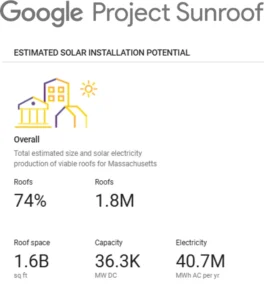Commercial Solar is More Than Big Savings
Top Reasons Commercial Rooftop Solar is a Great Choice in Massachusetts
Nationwide, there is competition between utilities and business owners in expanding solar power production capacity in local regions. Utilities prefer large scale, also called utility scale, solar installations that are multiple megawatts in rating and often hundreds of megawatts. These are referred to as metered systems. The utilities charge for that production in the same way they meter and charge for production from any other plant, gas fired or others.
Businesses and homeowners have good reasons to invest in a solar energy system in contrast to the utilities goals. A rooftop solar energy system is typically described as behind the meter (BTM). In Massachusetts, BTM systems provide solar generated electricity to your facility first, and without any metering and charges from the Eversource or National Grid. Any momentary excess is returned to the grid, and you are reimbursed using a net metering plan, where a customer is given credit for every kilowatt-hour (kWh) of electricity sent to the grid.
The financial savings from going solar are well established. See Three Business Benefits to read more. Here are more top reasons Cabral Solar customers may elect to invest in local solar:
Massachusetts has limited land availability for large solar energy farms.
The state is home to over seven million people within about 10.5k square miles. It is the third most densely populated of the 50 United States. Open land and forested acres are partly protected from use for this reason. Developers target brownfield sites and landfills for larger solar installations because they are otherwise unused and unusable. Although not entirely blocked by policy and regulations, using large parcels of land for solar in the state is more difficult than in other larger and less populated ones. Making use of existing and newly constructed rooftops and parking areas makes sense for these reasons:
The state has guidelines which limit size and location. Local authorities have other guidelines.
- Utility scale ground mounted systems require clear cutting of vegetation.
- Analysts conclude that over thirty-six gigawatts of rooftop solar capacity are available in the state, with barely 10% tapped.
In 2015 Google launched Project Sunroof as a calculator to help homeowners and businesses determine their energy potential with a rooftop solar energy system. It has since been used to estimate the overall potential for rooftop solar power in each of the fifty states. The Google Project Sunroof estimate for Massachusetts indicates 74% of available roofs are viable. A total of 1.8 million roofs are candidates. To date, less than 10% of those viable rooftops are generating solar power.
Rooftop solar provides both electricity and shade.
By generating electricity on-site, a business will significantly reduce the reliance on utilities and the electricity supplied from the grid. With the Massachusetts net metering program, momentary excess electricity generated by the solar energy system will be returned to the grid. The utility compensates you for this returned power at a net metered rate. By offsetting with local generation and getting credit for excess, the financial benefits increase. The more rooftop area covered by solar panels, the greater the secondary benefits from shading. The resulting cooling load can be significant:
- Rooftop PV absorbs 20 to 26 percent of the sunlight that hits it by converting it to energy. That reduces the heating of the building, peaking in the summer months.
- Studies have proven there is a net cooling load reduction which translates to a lower demand for the solar energy system and the utility grid as a result. So, a business owner is self-generating power and to a degree also reducing load – both a reduction of power purchased from the utility via the grid.
The future is electric.
Predictions of future electricity demand growth vary from 8% to 12% over the next three to five years. Increasing demand requires grid improvements and grid management becomes more complex. Here are key facts about the increasing demand for power:
- AI and data centers are exploding and require utilities to provide infrastructure. Their electricity consumption has tripled in the last decade. At the current growth rate, demand could expand threefold by 2028. All ratepayers will be charged to cover infrastructure improvement costs. While many new facilities are co-investing in solar and wind farms, more will be demanded from the grid.
- Transportation is electrifying at a growing rate. 10% of personal vehicle sales in 2024 were EVs.
- The only protection a business has against the factors driving up utility costs is to self-generate as much power as possible.
At Cabral Solar, we are always operating with a “customer first” approach. In every stage of the EPC project process, we communicate the essential progress to each client and consult and advise whenever key decisions are needed.

